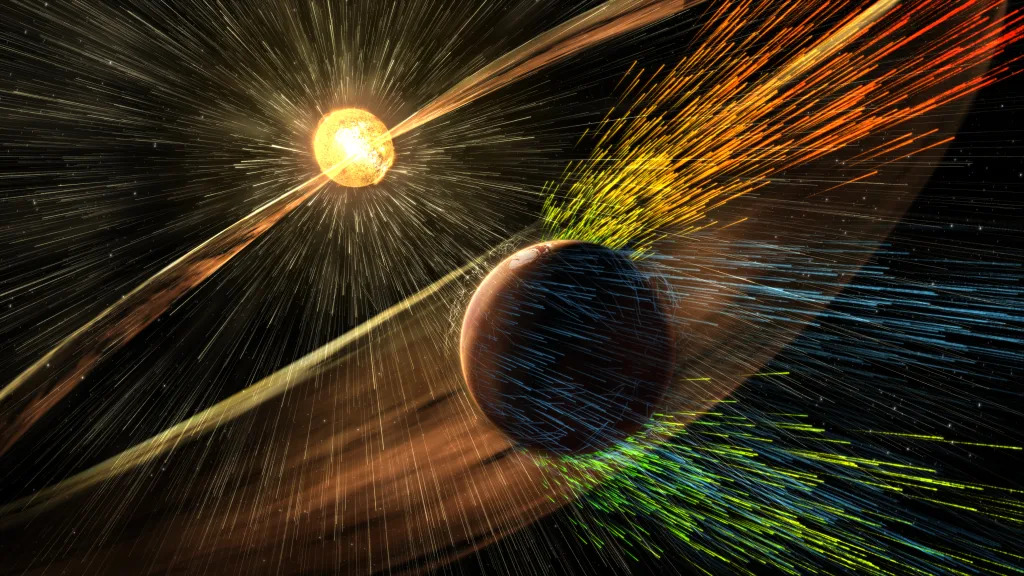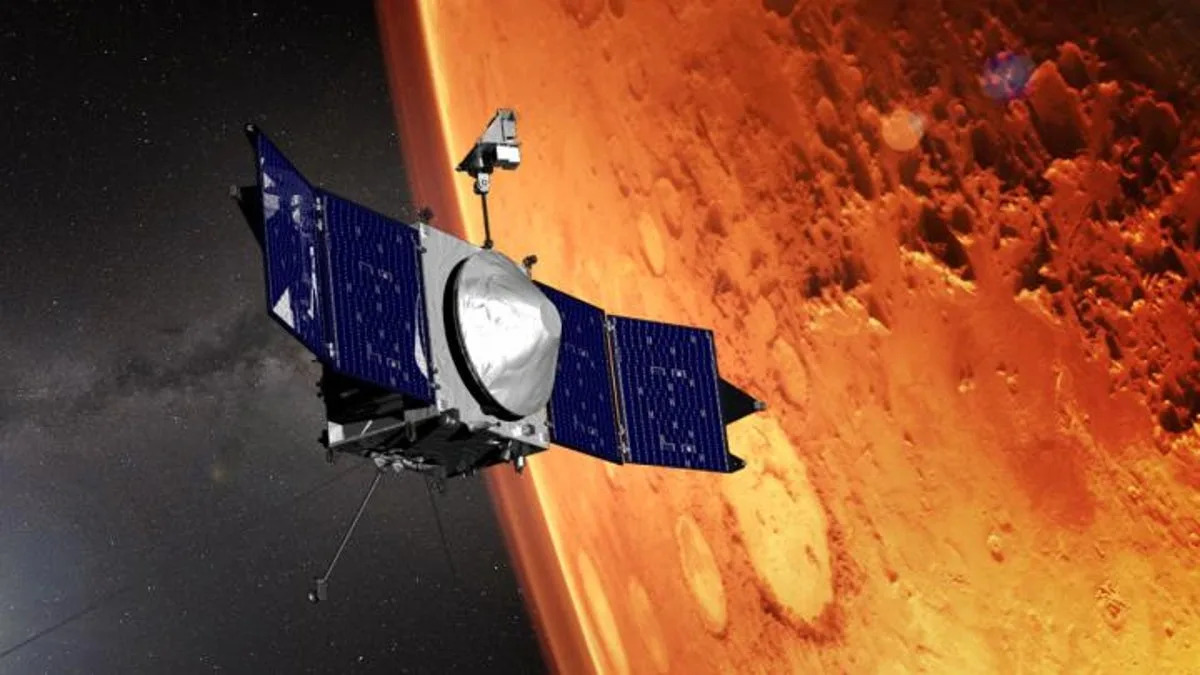Mars' atmosphere swelled like a balloon when solar wind stopped blowing. Scientists are thrilled
Sharmila Kuthunur
Wed, December 13, 2023

Artist's rendering of a solar storm hitting Mars and stripping ions from the planet's upper atmosphere.
Mars' atmosphere, once as thick as if not thicker than Earth's today, is leaking into space.
About 0.25 lbs of Mars' atmosphere (0.11 kg) is pushed away every second by the incessant solar wind, the speedy stream of charged particles routinely blasted from the sun which pervade the solar system and even reach beyond Pluto.
But for a rare two days last December, some of that wind went away. Its sudden and dramatic disappearance caused the atmosphere on Mars' sun-facing side to swell by nearly four times its usual size — from its usual 497 miles (800 km) to over 1,864 miles (3,000 km). The peculiar event was recorded by a NASA orbiter named MAVEN (short for Mars Atmosphere and Volatile Evolution) which has been observing both Mars's atmosphere and its response to the sun's behavior since 2014. MAVEN's data showed other aspects of the Martian system, including the tear drop-shaped magnetosphere, the bow shock and the ionosphere expanded similarly.
"We're really off the charts here," Jasper Halekas, a professor of physics and astronomy at the University of Iowa and a member of the MAVEN team, said on Monday (Dec. 11) at the AGU conference being held this week in California and online. "This is something that we haven't seen at Mars before with MAVEN."
Related: Lost in Space: How Mars' Atmosphere Evaporated Away
The atypical episode — the first in nearly a decade of MAVEN's career — occurred after a fast-moving region of a solar wind overtook its slower counterpart and swept up the latter's material, leaving behind a sparse region. The emptied storm reached Mars on Dec. 25, 2022, giving scientists a thrilling front-row seat to watch the planet's atmosphere balloon out, the way it might have been if it were circling a less 'windy' star.
"This was a Christmas present for us," said Halekas, who is leading a new study reporting this event. "Nature set up this perfect science experiment."
With MAVEN's data of the unexpected dynamics on Mars, Halekas and his colleagues studied how extreme solar events — and their absence — influence the planet's atmosphere, an insight valuable to understanding its evolution. The findings also have implications for our understanding of Earth-like planets outside our solar system and how they interact with their host stars, the team shared on Monday.
"We could look under the hood at what physics is going on, how the dynamics are working and really get a sense of those details," said MAVEN team member Skylar Shaver of the Laboratory for Atmospheric and Space Physics in Boulder.
Two days after the almost-vacant storm passed Mars, the atmosphere around the Red Planet settled down to its original state once again, but not before bouncing a little like a jiggling plate of Jell-O. A similar storm struck Earth in 1999, when our planet's atmosphere grew to five times its normal size. But there aren't often orbiting spacecraft positioned as well as MAVEN is now to study such events, the New Atlas reported.
Related Stories:
— 1st solar eruption to simultaneously impact Earth, moon and Mars shows dangers of space radiation
— Mars probe sees Red Planet atmosphere glowing green at night
— Sun halo on Mars! This Martian sky sight spotted by Perseverance rover was once thought to be impossible
Shannon Curry, the principal investigator for the MAVEN mission, suspects events like this were common during Mars' early evolution 3 to 4 billion years ago, when our sun was more fiery than it is now and perhaps blasted out storms once a week or even every day. Such extreme events were likely responsible for parching the Red Planet, a world scientists presume once hosted liquid water and offered conditions friendly toward life. Extrapolating the latest MAVEN data to study Mars' evolution through time could shed light on how much its atmosphere eroded away and how fast the planet dried up, Curry said.
Curry added events like this may occur multiple times in the next two years as the sun's activity climbs to its peak, expected to occur in July 2025 if not late next year.
Nasa makes ‘almost unbelievable’ discovery of Mars’s protective layer
Vishwam Sankaran
Thu, December 14, 2023

An extremely rare solar event that left a void in space resulted in “almost unbelievable” expansion of the Martian atmosphere by thousands of kilometres, Nasa revealed in a new study.
In December last year, Nasa’s Maven mission observed the sudden “disappearance” of a stream of charged particles constantly coming off the Sun, known as the solar wind – an event so powerful that it created a void in its wake as it traveled through the solar system.
Measurements revealed that the number of charged particles making up the solar wind dropped drastically during this event.
Without the pressure of the solar wind, the Martian atmosphere and magnetosphere expanded by thousands of kilometres, according to Nasa’s observations, being presented at the American Geophysical Union Fall Meeting in San Francisco.
“When we first saw the data, and how dramatic the drop in the solar wind was, it was almost unbelievable. We formed a working group to study the event, and we have found this period to be rich with incredible findings,” study co-author Jasper Halekas from the University of Iowa said.
Previous studies have shown that Mars, just like other planets in the Solar System, is constantly immersed in charged particles streaming from the Sun which exert pressure on the Red Planet’s sphere of magnetism that comes from the planet’s rotation.
The solar wind striking Mars drives much of the escape of its atmosphere.
During the December 2022 event, the density of the solar wind dropped by a factor of 100, and caused the pressure exerted on Mars to decrease, leading to the planet’s magnetosphere more than tripling in size.
The event was caused by faster-moving solar wind overtaking slower-moving wind, sweeping and compressing the two regions together.
This compression left behind a rare void of extremely low-density solar wind in its wake, Nasa scientists noted.
Researchers say this dramatic solar event and the Martian magnetosphere’s subsequent transformation can help better understand the physics driving water and atmosphere loss on Mars.
“MAVEN was designed to observe these types of interactions between the Sun and the Martian atmosphere, and the spacecraft provided exceptional data during this truly anomalous solar event,” Shannon Curry, another author of the study from the University of California, Berkeley said.
Such dramatic disappearing solar wind events are extremely rare, produced at a time of increasing solar activity, researchers say.
With the Sun currently moving towards the peak of its 11-year activity cycle, the latest findings can help provide an even better understanding of extreme solar events, they say.
“We are really getting to see how Mars responds when the solar wind is effectively removed. It makes for a great outlier study on what Mars would be like if it were orbiting a less ‘windy’ star,” Dr Halekas added.
Mars' Magnetosphere Suddenly Tripled in Size Last Christmas Day
Victor Tangermann
Wed, December 13, 2023

Wide Magnet
On Christmas Day last year, NASA's MAVEN spacecraft observed something entirely unexpected and exceedingly rare while orbiting Mars.
Specifically, it appears to have noticed the almost complete "disappearance" of solar wind, the steady trickle of charged particles coming from the Sun, in the wake of a powerful solar event, according to NASA.
The sudden lack of pressure from solar wind allowed the Martian atmosphere and magnetosphere to suddenly expand by thousands of miles — more than triple its regular size — catching scientists by surprise.
"When we first saw the data, and how dramatic the drop in the solar wind was, it was almost unbelievable," said University of Iowa Jasper Halekas, lead author of a new study being presented at the ongoing American Geophysical Union Fall Meeting, in a NASA statement.
"We formed a working group to study the event, and we have found this time period to be rich with incredible findings," he added.
Solar Windswept
As a result of being assailed by the Sun's particles, the Martian atmosphere is slowly disappearing, a process known as "atmospheric escape."
On the day of that dramatic solar event in December 2022, much faster-moving particles appeared to leave a void of "extremely low-density solar wind" behind, according to NASA.
That allowed the suddenly unencumbered Martian atmosphere and ionosphere to balloon to more than triple its usual size, causing the ionosphere to become temporarily unmagnetized.
The event was picked up by MAVEN's scientific instruments, allowing scientists to get a better sense of how these processes work.
"We are really getting to see how Mars responds when the solar wind is effectively removed," Halekas said. "It makes for a great outlier study on what Mars would be like if it were orbiting a less ‘windy’ star."
"MAVEN was designed to observe these types of interactions between the Sun and the Martian atmosphere, and the spacecraft provided exceptional data during this truly anomalous solar event," MAVEN principal investigator Shannon Curry added.

Wide Magnet
On Christmas Day last year, NASA's MAVEN spacecraft observed something entirely unexpected and exceedingly rare while orbiting Mars.
Specifically, it appears to have noticed the almost complete "disappearance" of solar wind, the steady trickle of charged particles coming from the Sun, in the wake of a powerful solar event, according to NASA.
The sudden lack of pressure from solar wind allowed the Martian atmosphere and magnetosphere to suddenly expand by thousands of miles — more than triple its regular size — catching scientists by surprise.
"When we first saw the data, and how dramatic the drop in the solar wind was, it was almost unbelievable," said University of Iowa Jasper Halekas, lead author of a new study being presented at the ongoing American Geophysical Union Fall Meeting, in a NASA statement.
"We formed a working group to study the event, and we have found this time period to be rich with incredible findings," he added.
Solar Windswept
As a result of being assailed by the Sun's particles, the Martian atmosphere is slowly disappearing, a process known as "atmospheric escape."
On the day of that dramatic solar event in December 2022, much faster-moving particles appeared to leave a void of "extremely low-density solar wind" behind, according to NASA.
That allowed the suddenly unencumbered Martian atmosphere and ionosphere to balloon to more than triple its usual size, causing the ionosphere to become temporarily unmagnetized.
The event was picked up by MAVEN's scientific instruments, allowing scientists to get a better sense of how these processes work.
"We are really getting to see how Mars responds when the solar wind is effectively removed," Halekas said. "It makes for a great outlier study on what Mars would be like if it were orbiting a less ‘windy’ star."
"MAVEN was designed to observe these types of interactions between the Sun and the Martian atmosphere, and the spacecraft provided exceptional data during this truly anomalous solar event," MAVEN principal investigator Shannon Curry added.
No comments:
Post a Comment